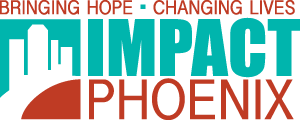Case Studies
The Distinctive Difference
Assisting a Young Single Mother in Rebuilding Her Life
Sadly, our communities are frequently called upon to assist a young single mother who is living in poverty or has just experienced being a victim of domestic violence. The real life contrast below illustrates how using a collaborative, wholistic, person centered approach, where resources are coordinated and technology-supported toolsets are used, results in sustainable life change. This contrast is based on two actual clients (Corrine and Maria) with two different experiences resulting in drastically different outcomes.
A Case Study of Hope
| Isolated Service Delivery System Approach | IMPACT Phoenix Approach |
|---|---|
| Corrine works with an isolated service delivery system with minimal collaboration. | Maria works with a collaborative, wholistic and coordinated planning system that connects government, social service, and faith community resources. |
| Corrine becomes homeless and is able to have her presenting need (housing) met. | After becoming homeless, Maria receives housing but also a trained Change Partner completes a comprehensive assessment which identified needs beyond stable housing such as transportation, employment, education, budgeting, life skills training, child care, mentoring, tutoring for her children, basic hygiene supplies, wholesome friendships, and a spiritual connection. |
| Corrine is now safe (crisis intervention only) but doesn’t have a long-term plan. | Within a short time of becoming stable, Maria and a Change Partner complete a plan addressing 15 areas of life with goals and action steps. |
| The housing agency provides safe comfortable housing but unfortunately is not programmed nor funded to provide much beyond that service. The agency doesn’t have sustainable relationships with other community agencies. Corrine therefore is left to spend her days searching for community resources on her own. | Multiple community entities participate in Maria’s plan by providing resources and services to meet her immediate needs and long term goals. Information, with the permission of Maria, is shared among the participating entities so that they can effectively assist Maria in successfully completing her plan. |
| Corrine gets frustrated with the number of times she has to repeat her story to the agencies she identifies that might be able to help her. | The technology supported plan that Maria and her Change Partner create allows for a coordinated approach that: reduces time spent by Maria repeating her story; reduces duplication of data entry by the various entities assisting Maria; increases the time spent building a relationship and trust between the provider and Maria; increases coordination of services; increases the likelihood that Maria will be able to sustain her change efforts; and reduces ‘system’ costs so that more ‘Maria’s’ can be helped. |
| Without a plan and no one available to hold her accountable, Corrine picks and chooses what services she wants to access and often times isn’t able to follow through with appointments and tasks required. | With a plan, Maria shares accountabilities with collaborating agencies and is responsible to follow through with specific steps to achieve her life goals. |
| The initial agency that Corrine receives housing from uses a manual system that is cumbersome and time consuming. The system primarily tracks the number of days that Corrine is housed but doesn’t track how Corrine is doing in accessing other community resources and if she is successful in making changes in her life. | Entities that are assisting Maria use sophisticated, yet user-friendly toolsets to support the work of the Change Partner. Maria is intrigued and excited by the toolsets and is able to access the software to adjust her plan as needed. The entities are able to show Maria the progress she is making through tracking step and goal completion. Maria is encouraged by how far she has come in rebuilding her life. |
| Corrine finds that traditional government and social service agency resources are limited and in fact decreasing because of funding challenges. She becomes frustrated because she can’t get the assistance she needs to make permanent changes. | Maria has access to centers of faith that contain untapped human, physical, and financial resources and greatly expands availability of effective resources so Maria can get what she needs to complete her plan. Maria now also has a caring, compassionate spiritual connection that can be life changing. |
| The staff at the housing provider is caring and wants to help Corrine. However, their caseload is high because they are funded based on the number of people they serve. They also want to make sure everyone receives some minimal services with the decreasing funding they receive. | Maria seldom experiences a lack of entity staff available to assist her because adequate funding exists. She learns that an increasing number of funders are providing resources to collaborative networks of community resources that are working together on plans and services to lift individuals out of dependency and into productive lives. Having tools and processes to work collaboratively also opens up new sources of funders from outside the community who reward communities who are: 1) working together in innovative ways to rebuild lives and communities; and 2) producing data-driven results. |
| Corrine primarily spends her day away from the housing provider and when she has the initiative, transportation, and child care, she attempts to access other community providers that might be able to help her with legal services, employment, and care for her children. She doesn’t feel she has any consistent advocate. She’s unable to visualize how she will be able to rebuild her life. | Because of the frequent interaction with Maria, the participating collaborating entities are able to build a caring, long-term relationship with Maria, thus increasing her chance for success in rebuilding her life. Maria is gradually experiencing healing and empowerment to make changes and adjust to her new situation. |
